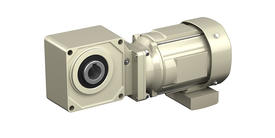
Hyponic Gearmotors in Baggage Handling Applications
Baggage handling requirements worldwide are becoming more and more demanding. Manufacturers of both conveyor systems, as well as system components such as power transmission gearmotors must meet progressively more robust specifications in order to be competitive in a global market. Drivers of these initiatives include customers and increased demand for better service, security needs, and pressure for virtually maintenance-free industrial machinery.
This paper will present the methodology and test results of a series of stop-start tests conducted on the Sumitomo Drive Technologies’ integral Hyponic gearmotor from July thru October 2009. These tests were conducted in such a manner as to simulate the function of a Queue Conveyor utilized in various strategic locations in baggage-handling conveyor systems at many airports worldwide. Although the requirement called for a series of 1~1½ million very aggressive start-stop cycles, we decided to proceed with a 2½ million cycle test for both our F Insulation Class and our H Insulation Class Gearmotors. The Duty Cycle / Speed Chart utilized called for a ramp-up-operate-ramp-down-stop of approximately 0.92 seconds per cycle.
Taking on the challenge of this requirement we conducted a series of tests which provided significant results data for the Hyponic Gearmotor. We concluded that both F and H Insulation Classes met the requirement without excess temperature rise nor motor coil degradation as strictly measured utilizing NEMA standards. Motor bearings were inspected in great detail and found to be completely free from fluting or any other kind of unwanted effect from the VFD-driven setup. The geared components were examined per AGMA guidelines for any indication of wear or damage; none was found. In fact, the mechanical power transmitting components were deemed to be in a near-new condition, and it was decided to allow one of the tests to continue to failure. As of this writing this particular unit has reached almost 15 million cycles with no indication of failure as monitored by various data logging and analysis equipment. This unit will continue to be tested and subsequent results will be published as an addendum to this report.
One of the reasons the Hyponic integral gearmotor can withstand such testing and come out with exceptional performance is because of its design features such as the use of Hypoid gears as well as an optimum motor design enabling very low inertia compared to other manufacturers; for example, Hyponic 2 hp motors exhibit inertias on a magnitude of 1.6 to 2.5 times less than other comparable motors. These and other features enabled the Sumitomo Hyponic Series integral gearmotor to truly perform exceptionally in these tests. Conveyor manufacturers and end-users have various choices in selecting drives for their equipment and of course the Hyponic is not the only solution. However, based on specific data which is summarized in this report and is available from Sumitomo Drive Technologies, we feel that the Hyponic in fact may be one of the better if not a best solution for the needs of the market, manufacturers and users, in terms of long-term reliability and design flexibility.
